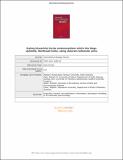Dating blueschist-facies metamorphism within the Naga ophiolite, Northeast India, using sheared carbonate veins
Abstract
The tectonic significance of blueschist-facies rocks associated with the Indo-Myanmar ophiolite belt is uncertain, given the lack of detailed petrological study and the paucity of reliable age data for different stages in their geological evolution. Here, we present new integrated petrological and geochronological data for samples from the Nagaland complex of the Indo-Myanmar ophiolite belt, northeastern India, which constrains the pressure–temperature conditions and absolute ages of peak and retrograde metamorphism. Several samples of blueschist were collected from the region, which have been variably deformed and subjected to shear recrystallization. Based on microstructural constraints and mineral geochemistry, garnet, omphacite, barroisite, chlorite and muscovite are interpreted to represent a high-pressure prograde-to-peak metamorphic assemblage, and omphacite, actinolite, hornblende and albite represent a lower-pressure retrograde metamorphic assemblage that formed during shear-related exhumation. Petrological modelling and thermobarometry indicates that unsheared samples equilibrated at ~1.9 GPa and ~480–520°C at peak metamorphism, indicating subduction to ~60 km depth, whereas sheared and recrystallised samples re-equilibrated at ~0.6 GPa and ~470°C during retrograde metamorphism associated with obduction of the Naga ophiolite onto the Indian foreland. U–Pb in-situ analysis of carbonate grains (aragonite–calcite) and associated silicate phases (epidote, prehnite, amphibole, etc.) at different microstructural positions, including within dynamically recrystallised shear bands that cross-cut older metamorphic fabrics and cogenetic silicate phases, constrains the age of peak metamorphism to be c. 95 Ma and retrograde metamorphism to be c. 90 Ma. Based on the overall progression of ages in the sheared and unsheared samples, we interpret that the area experienced exhumation at a time-averaged rate of ~1 cm/year in the order of Phanerozoic period plate tectonic rate, which is in the order of rates of plate tectonic processes on the Phanerozoic Earth.
Citation
Maibam , B , Palin , R M , Gerdes , A , White , R W & Foley , S 2022 , ' Dating blueschist-facies metamorphism within the Naga ophiolite, Northeast India, using sheared carbonate veins ' , International Geology Review , vol. 65 , no. 3 , pp. 378-395 . https://doi.org/10.1080/00206814.2022.2048271
Publication
International Geology Review
Status
Peer reviewed
ISSN
0020-6814Type
Journal article
Description
This work was supported by the Indian National Science Academy [1A/DFG/2015]; FIST Programme, Department of Science and Technology, Government of India [SR/FST/ESI-137/2014(C)]; Council of Scientific and Industrial Research, Government of India [24/0325/12/EMR-II].Collections
Items in the St Andrews Research Repository are protected by copyright, with all rights reserved, unless otherwise indicated.

